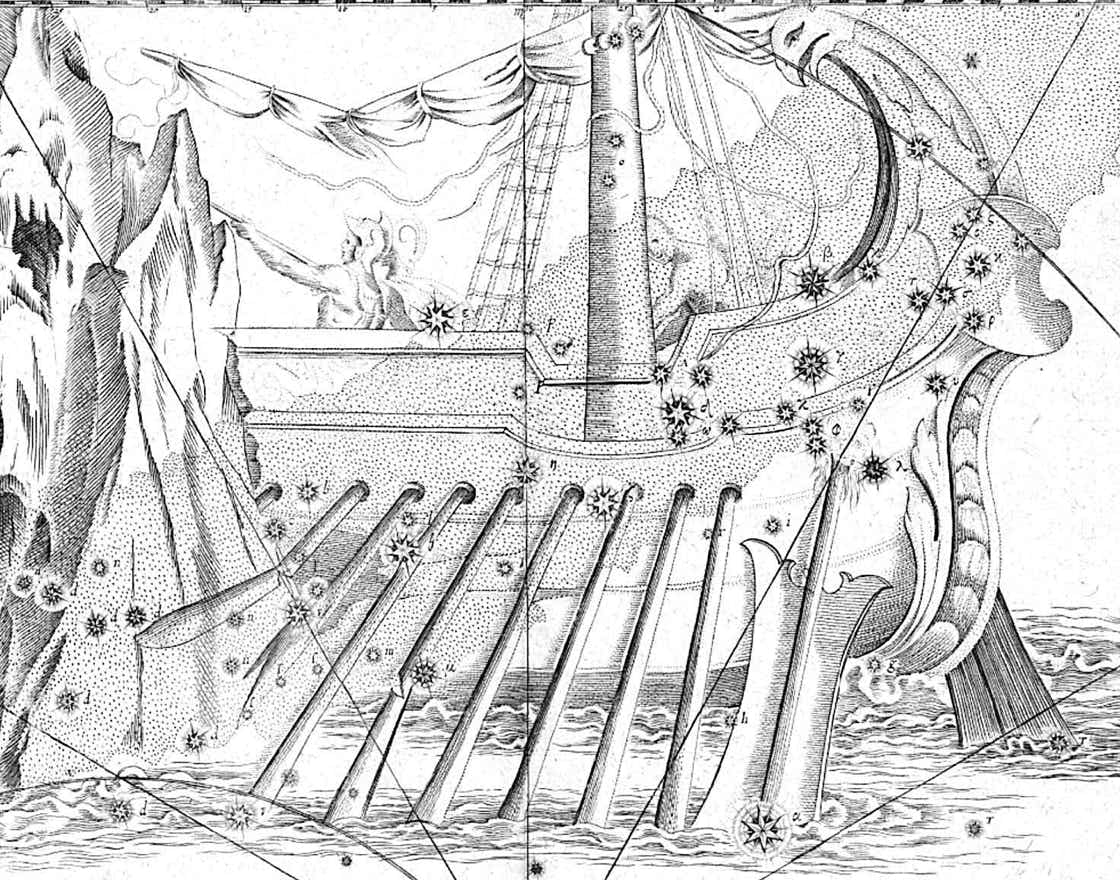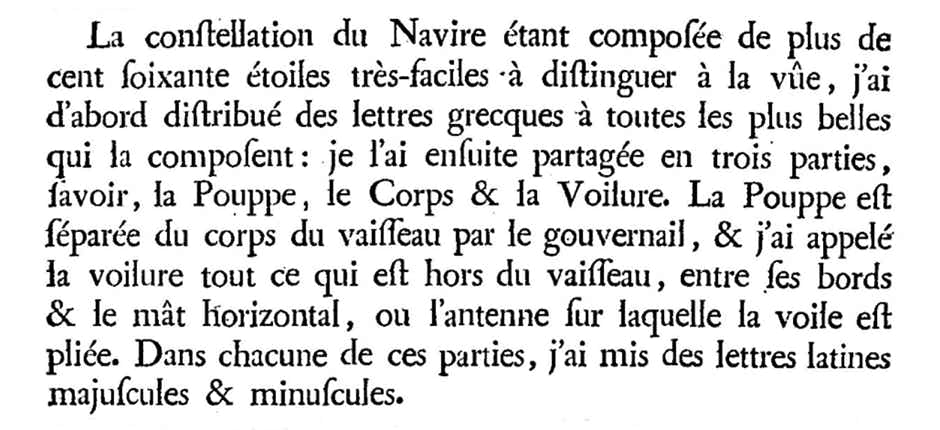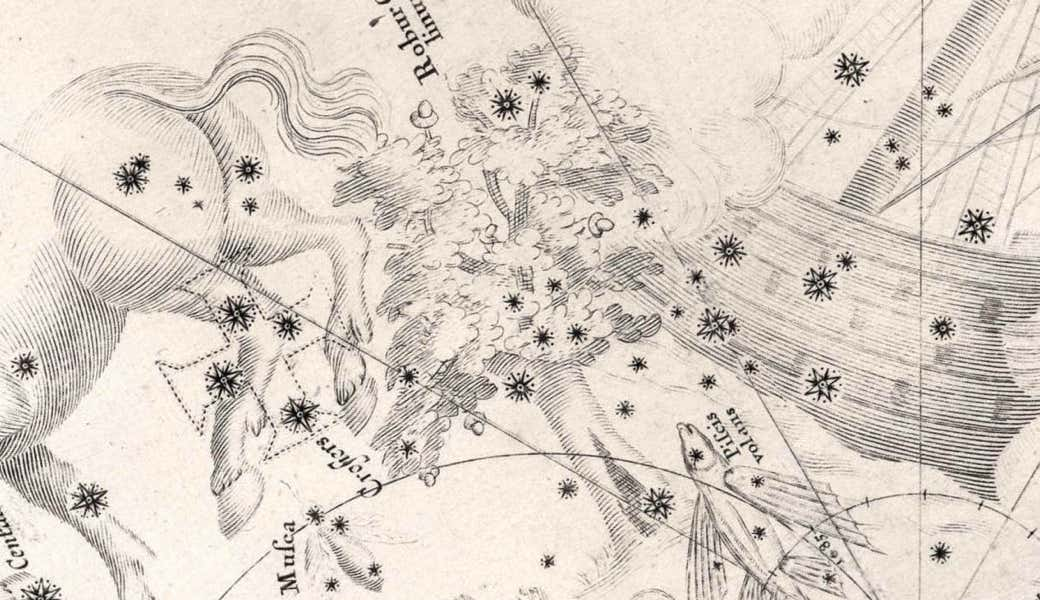
Genitive: Velorum
Abbreviation: Vel
Size ranking: 32nd
Origin: Part of the original Greek constellation Argo Navis
One of the three sections into which the French astronomer Nicolas Louis de Lacaille divided the oversized Greek constellation of Argo Navis, the Argonauts’ ship, in his southern star catalogue of 1756. In that preliminary catalogue he gave it the French name Voilure du Navire, which was Latinized to Vela in his final catalogue, Coelum australe stelliferum of 1763.
Vela represents the ship’s sails; the other sections are Carina, the Keel, and Puppis, the Stern. Lacaille wrote: ‘I have called the sails [i.e. Vela] everything outside the vessel between the edges and the horizontal mast, or the spar on which the sail is reefed’.
Traditionally the sail of Argo has been shown furled around a cross-spar on the main mast, as in this illustration from the Uranometria of Johann Bayer (1603). It was also shown this way on the charts by Hevelius, Lacaille, Flamsteed, and Bode (see here for a selection of images).
Not only did Lacaille dismantle Argo Navis, he also relabelled its stars, since he was dissatisfied with Bayer’s earlier arrangement. But he still used only one set of Greek letters for all three parts of Argo. As a result, Vela possesses no stars labelled Alpha or Beta, since these letters were allocated to the two brightest stars in Carina. For fainter stars in each constellation Lacaille turned to Roman letters, both lowercase and uppercase.
Vela’s brightest star is Gamma Velorum, a double star of combined magnitude 1.7. Delta and Kappa Velorum, along with Epsilon and Iota Carinae in adjoining Carina, form a cruciform shape known as the False Cross; this is sometimes mistaken for the true Southern Cross, although it is larger and fainter than the real thing.
Ptolemy in the Almagest had assigned four stars to the mast of Argo, as seen in Bayer’s chart above, two in the middle and two near the top. Lacaille incorporated these in a new constellation that he originally called la Boussole, the mariner’s compass, now known as Pyxis. In 1844 John Herschel proposed returning these stars to Argo in the form of a fourth subdivision called Malus, the mast, but this idea did not catch on.
Chinese associations
Five stars in Vela formed the Chinese constellation Ji, representing a temple to Hou Ji, the god of cereals. Ji itself refers to millet, which was the main crop in ancient China. However, the exact stars involved are uncertain.
Even greater uncertainty surrounds other Chinese constellations in this far southern area of sky. One such is Tianshe, ‘celestial altar’. In Chinese fable, Tianshe represented an altar used to make offerings to the Earth god Julong. One version identifies its six stars as Gamma, b, Omicron, Delta, Kappa, and N Velorum. Sun and Kistemaker, though, depict it zig-zagging from Chi Carinae via Gamma Velorum and on into Puppis, while a third interpretation confines it to Puppis alone. Another problematic constellation is Qifu, a storehouse for musical instruments, consisting of 32 stars mostly in Centaurus but perhaps spilling over into Vela as well.
Two or three stars in northern Vela, including q and i, formed part of Dong’ou, which straddled the border with Antlia. This constellation was named after a place on the Chinese coast where barbarians were said to live.
One individual star in this region was known as Tianji, representing an assessor who decided whether animals were old enough to be sacrificed. This star has been identified either as Lambda Velorum or 12 Hydrae; the latter identification may be more probable as it would place it closer to the kitchen, Waichu, in Hydra where the animals were actually slaughtered.
© Ian Ridpath. All rights reserved
Lacaille’s description of his division of Argo into three parts: the stern or poop deck (Pouppe), the hull (Corps), and the sails (Voilure).
The Southern Cross, left of centre, and the False Cross at right, seen against the hull of Argo, on Edmond Halley’s southern star chart of 1678. Halley’s short-lived invention of Robur Carolinum lies between them. The modern designations of the stars in the False Cross are Kappa and Delta Velorum (top and right of the cross), and Iota and Epsilon Carinae (left and bottom), all of second magnitude.





